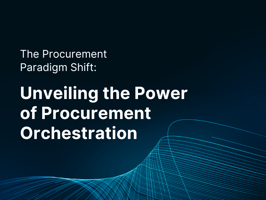In the dynamic world of procurement, a groundbreaking concept is gaining momentum – procurement...
5 Mistakes to Avoid when Tackling Procurement Orchestration

Procurement orchestration is an emerging strategy designed to streamline procurement processes, enhance efficiency, and reduce risks by automating and coordinating activities across systems, processes, and teams. While the benefits are significant, many organizations stumble in their orchestration journeys due to common pitfalls. Here are the top five ways to fail with procurement orchestration and how to avoid them.
1. Confusing Orchestration with Integration
One of the most common mistakes is confusing orchestration with integration. Integration refers to connecting different systems to allow them to work together, while orchestration involves coordinating these systems, processes, and people to achieve a seamless workflow. Many organizations mistakenly view orchestration as a solution to fill feature gaps in their current technology investments, which leads to underutilizing its full potential.
To avoid this mistake, it's crucial to understand that orchestration is about creating cohesive and efficient process flows. It involves automating the coordination of tasks and ensuring that all parts of the procurement process work in harmony. This means going beyond simply connecting systems and focusing on how these systems can work together in concert with human users to deliver optimal outcomes. Investing in orchestration platforms specifically designed for procurement can help ensure that all elements are effectively coordinated, providing a seamless user experience and improving overall process efficiency.
2. Using a General-Purpose Orchestration Platform
Another common error is attempting to use a general-purpose orchestration platform that wasn't built for procurement. While these platforms may offer flexibility and customization, they often lack the specialized features and functionalities required to handle the complexities of procurement processes. As a result, organizations may struggle with inadequate support for procurement-specific use cases, leading to inefficiencies and frustration.
To overcome this challenge, it's essential to choose an orchestration platform tailored to procurement needs. These platforms come with pre-built templates, modules, and integrations that cater specifically to procurement processes, ensuring that they address the unique requirements of procurement professionals. By selecting a purpose-built platform, organizations can achieve faster implementation, reduced customization costs, and better alignment with procurement objectives.
3. Starting with the Wrong Procurement Use Case
Starting with the wrong procurement use case can significantly derail orchestration efforts. Organizations often choose complex or high-stakes processes as their starting point, hoping to achieve immediate and impactful results. However, this approach can lead to long implementation times, high costs, and increased risks of failure.
A more effective strategy is to begin with simpler, high-volume processes that can be easily automated and deliver quick wins. These processes often have clear and measurable outcomes, making it easier to demonstrate the value of orchestration to stakeholders. For most organizations, the best place to start will be to provide business partners with a single, unified intake experience. A ‘procurement front door’ not only helps to solve an important user experience challenge and leads to higher rates of adoption and compliance, but the high visibility will make it easier to make a case for automating additional workflows.
As confidence and expertise grow, organizations can gradually tackle more complex use cases, building on their initial successes and scaling their orchestration efforts effectively.
4. Not Having Leadership Buy-In and an Executive Champion
Successful procurement orchestration requires strong leadership support and an executive champion to drive the initiative forward. Without leadership buy-in, orchestration projects may lack the necessary resources, attention, and prioritization, leading to stalled progress and limited impact. Additionally, an executive champion can help navigate organizational politics, secure funding, and communicate the strategic importance of orchestration to all stakeholders.
To gain leadership buy-in, it's important to clearly articulate the benefits of procurement orchestration, such as reduced cycle times, improved compliance, and enhanced user experiences. Presenting a compelling business case with data-driven insights and real-world examples can help demonstrate the value of orchestration and secure the necessary support. Moreover, involving key stakeholders early in the process and keeping them engaged through regular updates and progress reports can help maintain momentum and ensure ongoing commitment.
5. Waiting for Clean Data
Waiting for perfect data before starting the orchestration journey is a common but misguided approach. While clean data is important for accurate reporting and decision-making, the pursuit of perfect data can delay orchestration efforts indefinitely. The reality is that data will never be perfectly clean, and waiting for it can prevent organizations from realizing the benefits of orchestration.
Instead of waiting, organizations should adopt a pragmatic approach by leveraging orchestration tools that can work with imperfect data. Modern orchestration platforms often come with built-in data cleansing and enrichment capabilities that can improve data quality over time. And by simplifying end user experiences, it becomes possible to ensure that manual data entry is kept to a minimum while putting rules and guidance in place to ensure that any data that is entered manually will be of higher quality in the first place. By starting the orchestration journey with the data at hand, organizations can begin to realize immediate benefits and progressively enhance their data quality as part of the orchestration process.
Procurement orchestration holds the promise of transforming procurement processes, reducing cycle times, improving compliance, and enhancing user experiences. However, success depends on avoiding common pitfalls such as confusing orchestration with integration, using unsuitable platforms, starting with the wrong use cases, lacking leadership support, and waiting for perfect data. By addressing these challenges head-on and adopting a strategic approach, organizations can unlock the full potential of procurement orchestration and drive significant improvements in efficiency and effectiveness.
Procurement professionals should remember that orchestration is a journey, not a destination. It requires continuous improvement, stakeholder engagement, and a willingness to adapt and learn. By taking a thoughtful and deliberate approach, organizations can successfully navigate the complexities of procurement orchestration and achieve lasting benefits.




